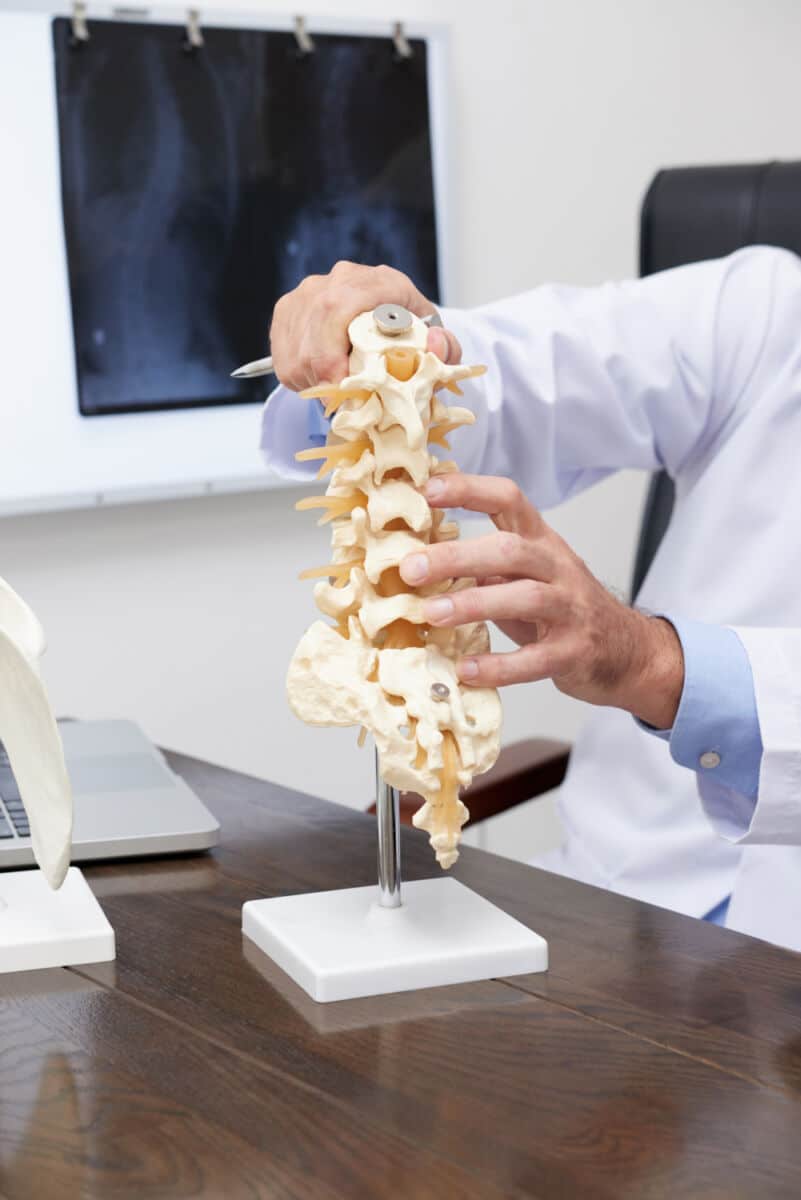How this spine surgery in Bangkok offer faster recovery, smaller scars, and better outcomes
Two tiny cuts, one massive relief: Unilateral Biportal Endoscopy (UBE) spine surgery can get you walking the next day

When you think of back surgery, what comes to mind? For most people, it’s something intense that involves a big cut down the middle of the back and weeks or months of recovery. That image is still accurate in many operating rooms, but a growing number of spine surgeons in Bangkok are choosing a minimally invasive technique called Unilateral Biportal Endoscopy (UBE) spine surgery.
According to Dr Krittsadakorn Kachonkittisak, an orthopaedic surgeon at MedPark Hospital Bangkok, UBE spine surgery is precise, fast, and for the right patient, it can get you back on your feet faster than you’d ever expect.
But what exactly is UBE spine surgery and how does it provide faster recovery? If you or someone you care about is dealing with a herniated disc, spinal stenosis, or recurring back pain that just won’t quit, here’s what you need to know.
Quick summary
| Section | Summary |
| What is UBE Surgery? | A minimally invasive spine procedure using two small incisions and a high-definition camera. |
| Who it’s for | Suitable for patients with disc herniation, spinal stenosis, or mild spondylolisthesis. |
| Why it’s not more common | Suitable for patients with disc herniation, spinal stenosis, or mild spondylolisthesis. |
| Common myths | Not experimental, not limited to simple cases, and often safer than open surgery. |
| What to expect at MedPark Hospital | Pre-op consultation, 1–3 hour surgery, next-day mobility, and short hospital stay. |
| UBE as the future | A faster, less painful alternative that could redefine recovery for back surgery. |
What is UBE and how is it different from traditional spine surgery?
Traditional open spine surgery involves a large incision on the back, and muscles are stripped or pulled back to give the surgeon access to the area. This often leads to considerable blood loss, post-operative pain, and extended recovery time.
As a minimally invasive spine surgery (MISS), UBE takes a different route. Instead of opening up the entire area, surgeons make two small incisions (portals), each typically less than a centimetre, on one side of your back. One portal is used for inserting a high-definition camera… the other portal is used for inserting specialised surgical instruments,” explained Dr Krittsadakorn.
The surgeon sees everything through a high-definition camera and works with incredibly precise tools. There’s continuous fluid irrigation to keep the view clean and bleeding under control. Movements are deliberate, controlled, and less disruptive to surrounding tissue.
“UBE aims to achieve the same surgical goals as traditional surgery… but through a less invasive approach, leading to potential benefits like reduced tissue trauma, less pain, faster recovery, and smaller scars,” he added.
Who’s it for?

UBE is a versatile spine surgery technique that can be used for various degenerative spinal conditions. These include disc herniation, spinal canal stenosis, and mild spondylolisthesis (that’s when one of your vertebrae slips forward), among others. Surgeons also use it for revision surgery as it offers a less invasive option for patients who’ve had previous procedures.
But who’s a good candidate? Essentially, anyone who’d normally qualify for traditional spine surgery, but who also wants a faster, less painful recovery. Age and overall health matter as well. For older adults or patients with certain underlying medical conditions, the minimally invasive nature of UBE can make a big difference.
In fact, some patients may actually need it because of the risks traditional surgery poses. That was the case for an 85-year-old man with diabetes and high blood pressure with severe leg pain Dr Krittsadakorn recalled.
“He visited with severe leg pain due to multiple levels of lumbar spinal stenosis, significantly limiting his ability to walk and engage in hobbies.”
With multiple levels of spinal canal stenosis and underlying health conditions, the risks of traditional open surgery were high. Recovery would’ve been long and potentially difficult, especially at his age. That’s why the surgical team at MedPark Hospital Bangkok recommended UBE decompression surgery, and the results were dramatic.
“He could ambulate (move around) immediately the first day after the operation. Because of effective decompression with significantly less surgical trauma… he regained his independence and quality of life more quickly than he might have anticipated with open surgery.”
However, there are certain cases where UBE is not recommended. Dr Krittsadakorn pointed out:
“Patients with significant instability requiring extensive fusion with many implants, severe deformities, certain types of infections, or extensive scarring from previous surgeries might be less ideal candidates for UBE alone.”
If UBE is safe, why haven’t you heard of it before?
One reason you might not have heard of UBE spine surgery before is access. UBE spine surgery requires a highly trained surgical team and specialised equipment, and not every hospital is set up to deliver that. Unlike more common procedures, UBE isn’t something surgeons can just add to their toolkit overnight.
“UBE has a steep learning curve and requires specific training and skills beyond traditional open spine surgery,” Dr Krittsadakorn noted.
We’re talking about advanced endoscopic skills, operating through two portals while watching a 2D monitor, and managing bleeding in a fluid-filled space, all while navigating the spine’s delicate anatomy. It takes dedicated fellowships, cadaver labs, and progressive experience to get it right.
Only a handful of hospitals in Thailand have surgical teams trained to perform UBE. MedPark is one of them.
That limited availability helps explain why you haven’t seen it featured in every back pain brochure or recommended by every orthopaedic surgeon. But its reputation is quickly gaining traction as more patients seek out minimally invasive spine surgery with shorter recovery times.
The myths
Like with many surgical techniques working its way to the mainstream, there are a lot of myths surrounding UBE spine surgery. One of them is that it’s experimental and riskier than traditional surgery.
“While newer than traditional surgery, UBE is a well-established technique, particularly popular in Asia, with a growing body of evidence supporting its efficacy and safety. It builds on principles of arthroscopy used in other joints for decades,” Dr Krittsadakorn said.
And yes, like all surgeries, UBE comes with its own risks, such as possible nerve irritation, infection, or dural tears. But when performed by trained surgeons, its safety profile compares favourably to open surgery, with some studies suggesting even fewer complications like blood loss or infection.
You might also have heard that UBE is only for simple cases, but that cannot be further from the truth. Experienced surgeons can address more complex issues like multi-level stenosis or even some types of instability using this technique.
What to expect if you go for UBE at MedPark Hospital Bangkok

UBE spine surgery is considered very safe. But as with any procedure involving the spine, peace of mind comes from knowing there’s a plan, and that it’s followed carefully.
At MedPark Hospital, the process begins well before the operating room. Patients first go through a detailed consultation. During this consultation, the surgeon reviews medical history, imaging scans (like MRI or CT), and bloodwork. You’ll also receive instructions about fasting and which medications to pause.
The procedure itself is performed under general anaesthesia and usually takes between one to three hours, depending on the complexity of the case. Throughout the operation, continuous monitoring ensures safety, and the team follows a standardised protocol from start to finish.
Recovery doesn’t wait. Most patients are encouraged to get up and walk either the same day or the following morning. Hospital stays tend to be short, usually around one or two nights.
Nurses, physiotherapists, and the surgical team work together for the post-operative care. Nurses handle pain management, wound care, and watch for any signs of complications. Physical therapists step in early to help with safe movement and recovery exercises. Follow-up appointments with your surgeon continue after discharge, helping monitor healing and adjust activity levels as needed.
Is UBE the future of spine surgery?
It just might be. With better tools, clear imaging, and proven results, UBE spine surgery is offering an alternative to the fear many people associate with traditional back surgery.
“I wish more people knew about the significantly less invasive nature of UBE surgery compared to traditional open surgery. Many fears came from the idea of large incisions, significant muscle damage, long hospital stays, and painful recoveries. UBE directly addresses these concerns with small incisions and minimal muscle disruption often translates to less post-operative pain, less bleeding, fewer complications, and a much faster recovery,” said Dr Krittsadakorn.
If you’re wondering whether UBE might be right for you, MedPark Hospital in Bangkok offers consultations with specialists trained in this technique. You can reach the hospital via medparkhospital.com or complete the enquiry form below.
Sponsored
Latest Thailand News
Follow The Thaiger on Google News:


























